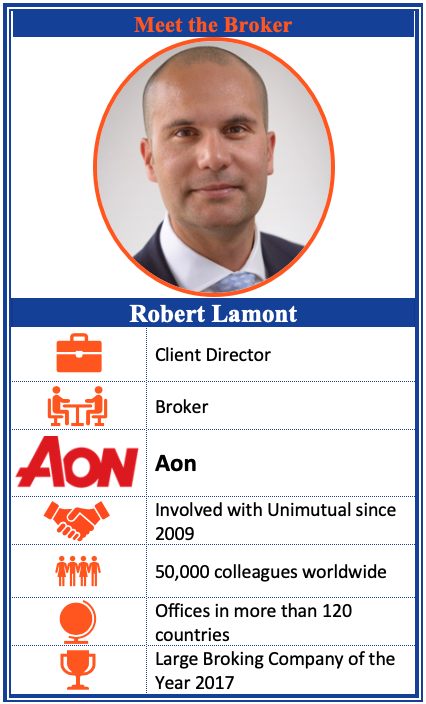
Broker Business Issue #3, 2019
July 23, 2019
Admissions Manipulation: A Future Risk to Australian Higher Education? – Emerging Risk Report: Issue 83
July 29, 2019In these Spotlight discussions, we speak to the individuals that make up the Unimutual community, to share the experiences of the parts that make up the whole.

Hi, my name is Robert Lamont. I’m a Client Director based in Melbourne and I work for Aon Australia. I’m responsible for Aon’s national education practice group.
What is Aon’s relationship and history with Unimutual?
When Unimutual formed, they really focused on a group of eight universities and that relationship has matured with Aon a lot over the last 10 years. We work very closely with the entire Mutual team across all the services and claims, risk management and risk transfer.
What are the current trends in insurance?
In terms of trends, what’s happening now, particularly in the context of the Australian insurance market, is that they’re looking for profit. They’ve had premium growth over a period of time, but they’re now turning their attention, driven by the investors, to make profit.
They do that by various means and one of which of course is risk selection. They’ll work very closely with their client base to make sure that the clients that they underwrite and put down capital (for) are managing risks properly.
What do you see as the biggest risks for the higher education sector?
Unquestionably the biggest risk that we have is what’s happening on the federal level with the education minister. What that person decides to do, in terms of how they allocate funding to the Australian University environment, will have the most dramatic impact. So the importance of government relationships with the vice-chancellors and that education minister is absolutely key.
The other thing that is prevalent that we’re watching very closely, of course, is anything connected to cyber. A large-scale cyber event that impacts course delivery will have considerable impact on the teaching experience for universities and therefore students.
How does being a Unimutual member improve your customer’s risk management?
From our perspective, Unimutual help develop that business hygiene – in terms of getting the risk management practices right, getting the risk engineering reports right, the crisis management, the business continuity, the valuations – so all those fundamentals need to be addressed and the Mutual play a key part in helping us work with clients on that.
“When we scour the market, we look at who focuses heavily on risk management, on risk transfer, on claims capabilities, who understands the sector and are specialists in the sector, who will pay a large claim and will be there from day two and three, etc. The Mutual for me ticks all of those boxes.”
What does Membership mean for your clients?
One of the things that our clients look for and absolutely do value, is the ability to speak to their peers at their fellow universities throughout Australia. We all have common challenges, common problems, and there’s nothing that one university has an experience with that another hasn’t seen before. We totally welcome conferences like this where people have the ability to share ideas.
Why does the relationship between broker and risk protection provider matter?
Clients pay us, as brokers, to really put them at the front of the queue in terms of premium terms and conditions, outcomes, leverage, etc. So if we don’t have an exceptionally strong relationship with the Mutual we offer diminished value to our clients so we absolutely focus on that.
How do you differentiate between price and value in risk protection?
We sit down with our clients and make sure they’re fully informed in terms of what’s happening from a global perspective in the industry, from a local perspective on the Australian insurers, and then we have discussions with regards to what’s happening in the Australian university setting.
From then we’ll talk about the topical issues, how losses have impacted either them directly or some of their fellow universities. Therefore, we’re having a conversation with them with regards to how they differentiate their risk profile so that when we engage with the Mutual to sell their risk profile, the work and investment that they’ve expanded on risk and risk management and resources is actually understood and therefore that differentiator comes into play.
What value does Membership have for your clients?
We see this all day and every day for our clients, those phone calls and emails that go back and forth between the Mutual and our clients are always answered in a very positive way. What’s important for us, and more importantly our clients, is that when they ask the Mutual these questions, their responses are backed with their wealth of knowledge, given that they’re the preeminent risk transfer partner to universities in Australia.
The other key aspect of course is claims. There’s multiple examples of universities having challenging, really problematic, complex claims where the likes of Jamie and others within the Mutual really come to the floor and really demonstrate the true value in terms of why you buy risk transfer product.
What sets Unimutual apart?
The things that we consider are; do they understand the sector? Are they specialists in their field? Will they pay large claims and still be there for you the next day? Do they have very strong claims management personnel? Do they have very strong risk management personnel? And what does that holistic service offering look like?
The Mutual buys a lot of reinsurance that sits behind the protection, so we take a very close look at that to make sure that the security that sits behind that program is robust and will be there year after year. The Mutual do that better than any other in my opinion.
What the Mutual do exceptionally well is just understand those unique nuances that exist at a university. So again, coming back to the example of temperature controlled environments, when those adverse events happen, they’re very difficult. So, you’ll speak to a researcher who’ll be in immense pain in terms of losing years of research, pretty much impossible to value and pretty much impossible to replace, so just the ability to have those sensitive conversations with the researchers and try and come up with a solution terms of monetary aspect is quite difficult and I think the Mutual does that well.
What do your clients and yourself get out of the conferences?
I’ve been coming to the Unimutual conferences for about a decade now. I’ve always enjoyed them-, it really is the preeminent risk management conference for universities in Australia. What we get out of the course is just the ability to spend time with our clients and universities across the whole setting. It truly is a collegiate atmosphere.
“As I mentioned before, they are all competitors, competing for the same funding, same research, same student body, but the willingness to share ideas and have conversations for common needs and goals is absolutely prevalent in a conference like this.”
What are the current trends in risk management?
Obviously, we always look at the risk landscape and there’s a lot of commentary and literature around things like cyber so we won’t talk about that but you really can’t do a lot wrong by focusing on the fundamentals. Things like risk engineering, having responses to all the recommendations that come in and taking proper due diligence and care with those responses is absolutely important.
What are the growth opportunities for Australia’s higher education sector?
For me it all leads towards collaboration and interaction with industry. The big one that’s absolutely relevant to the insurance industry is of course climate change, so from an insurance perspective, anything, any weather peril events; be it bush fire, windstorm, flood, hail, etc, that impacts multiple insurers has a dramatic impact on the industry. Anything that the university can do to interact with the industry in regard to that sustainability piece for the protection of the buildings as is a huge opportunity.
Are you seeing lots of new ventures being undertaken internationally?
Universities will always take a very close watch on the international aspect, largely driven around the ability to send their students offshore to have a wonderful student experience working in or studying in a different country and of course bringing students from other countries into Australia.
It’s very important from an insurance perspective that we’re there to partner with the universities as they negotiate through political and geographic environments that are vastly different from Australia.
What does having robust and accurate risk protection mean for the higher education sector?
We always try to avoid the scenario where insurance, and risk management and risk transfer, becomes a procurement exercise and effectively just a cost and another bill. So we work closely with our universities to make sure that their risk transfer program is of strategic benefit for them and enables them to interact with industry, to collaborate, to grow, to work overseas, to send students overseas and that our risk transfer programs are there supporting the universities in their strategic endeavours.
We previously spoke to Board Member, Darren Greentree – read his responses here.



